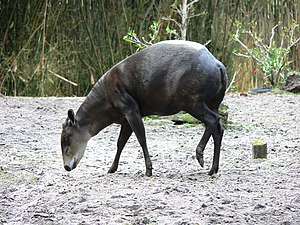Yellow bridge duiker
| Yellow bridge duiker | ||||||||||||
|---|---|---|---|---|---|---|---|---|---|---|---|---|

Yellow-bridge duiker ( Cephalophus silvicultor ) |
||||||||||||
| Systematics | ||||||||||||
|
||||||||||||
| Scientific name | ||||||||||||
| Cephalophus silvicultor | ||||||||||||
| ( Afzelius , 1815) |
The yellow-bridge duiker or giant duiker ( Cephalophus silvicultor ) is a species from the horn-bearer family. It occurs exclusively in Africa. There are up to six subspecies.
features
The yellow-bridge duiker can weigh up to 63 kilograms. With a shoulder height of up to 79 centimeters, he is the largest duiker .
A dark, gray-brown coat covers the body, a conspicuous, yellow-brown stain covers the rear part, which widens towards the rump. This has led to the German trivial name. Young animals initially lack this coat color. They do not develop until they are five to eight months old. Both sexes of the yellow bridge duiker have short, straight horns. These reach a length of up to 20 centimeters.
Almost nothing is known about the way of life of the yellow bridge duiker. They can reach an age of up to nine years.
distribution
The yellow bridge duiker lives in Central Africa from the Congo basin to Senegal and occurs in the nature reserves of Kafue , Upemba , Salonga and Virunga , among others . Thickly forested areas are part of its habitat. Like other duikers, he mainly lives individually and regularly uses worn bills. Its main diet consists of fruits, berries and mushrooms.
Danger
The population size of the Yellow Bridge Duck is estimated at around 160,000 individuals, the species is not considered to be endangered. Above all outside of protected areas, however, the number of animals is falling due to clearing of forests and hunting.
literature
- Clive A. Spinage: The Natural History of Antelopes. Croom Helm, London 1986, ISBN 0-7099-4441-1 .
Web links
Single receipts
- ^ Spinage: The Natural History of Antelopes. 1986, p. 176.
- ^ Spinage: The Natural History of Antelopes. 1986, p. 177
- ↑ Cephalophus silvicultor in the Red List of Threatened Species of the IUCN 2012. Posted by: IUCN SSC Antelope Specialist Group, 2008. Accessed November 14, 2012th